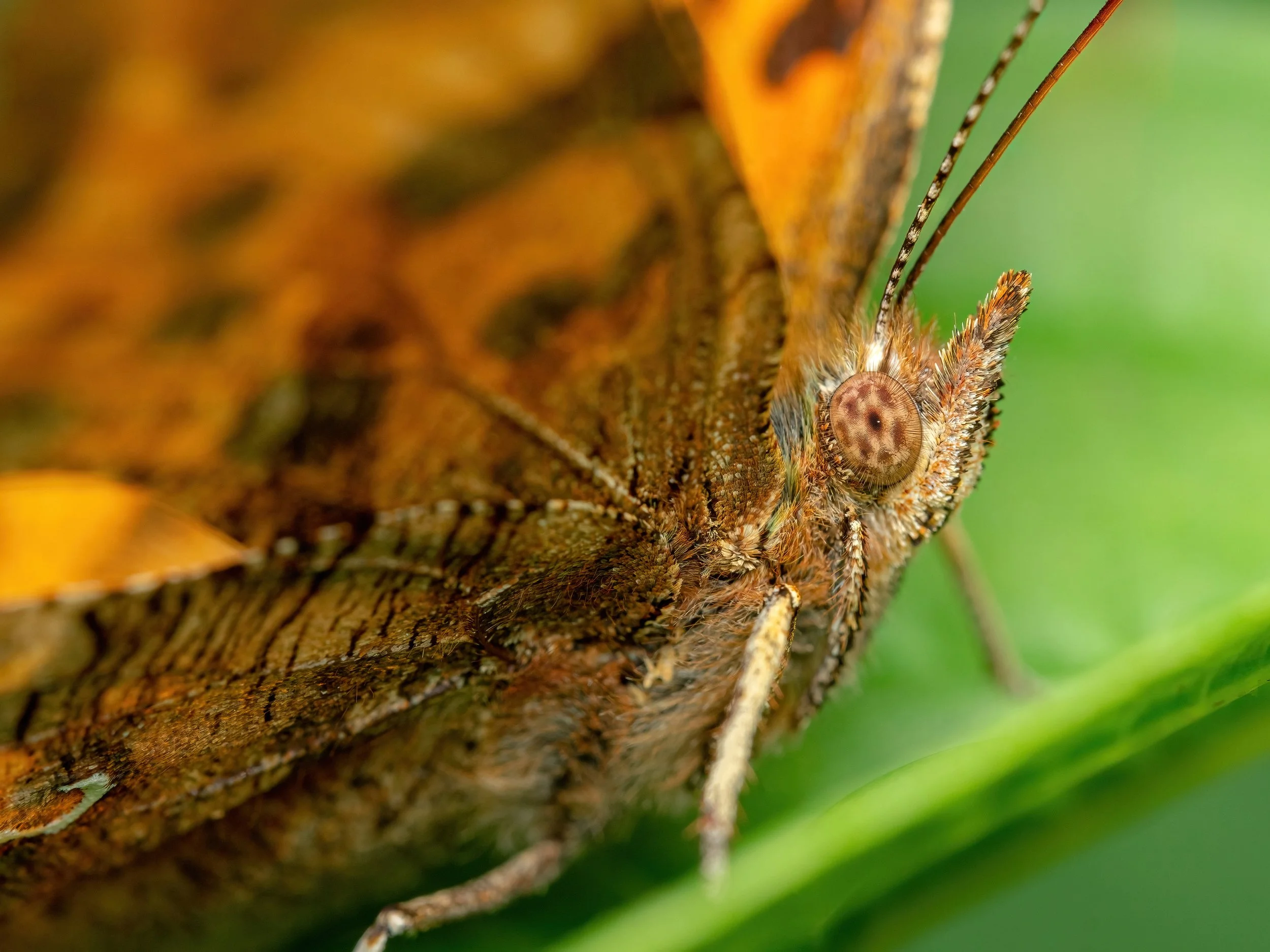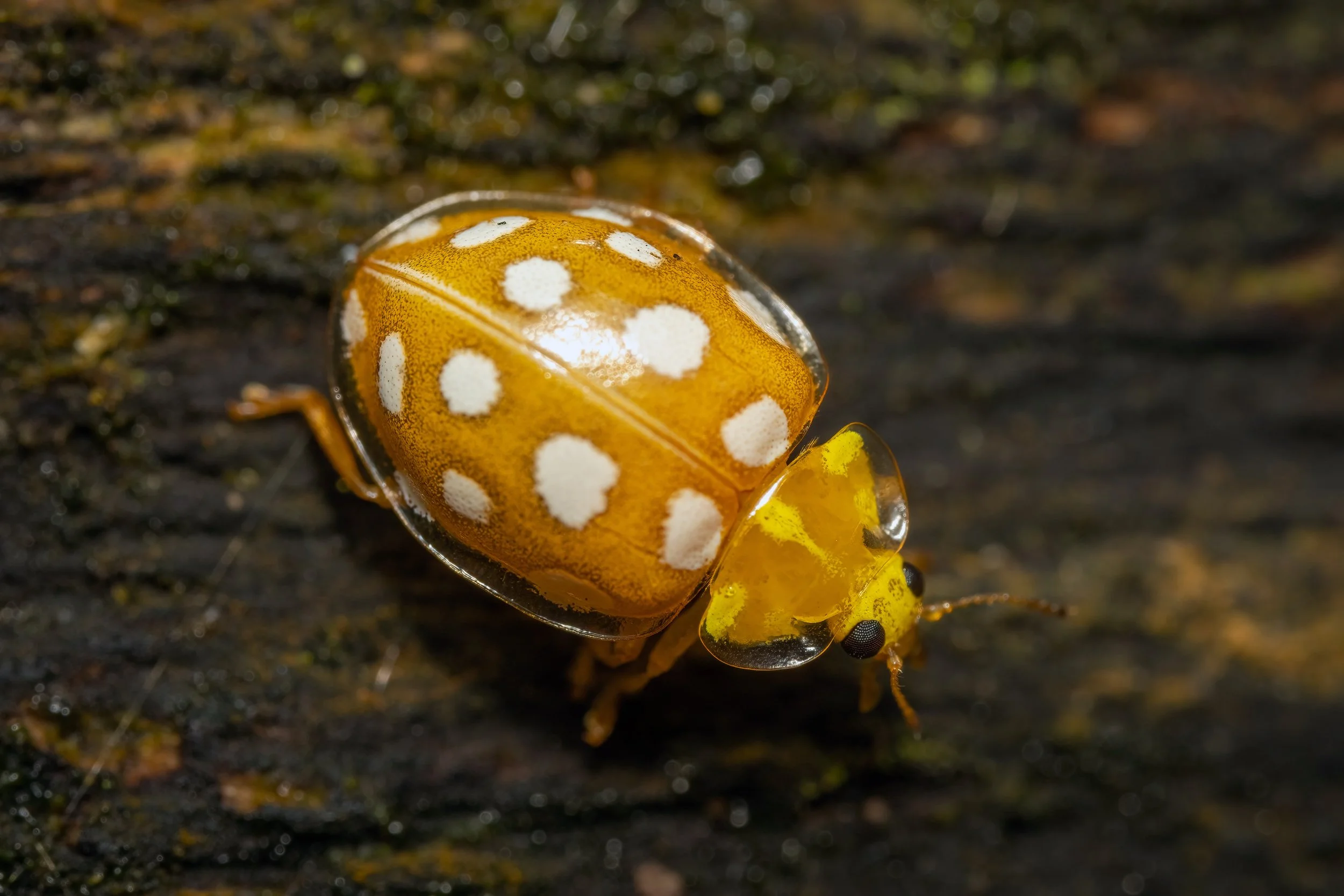
Insect Macro Personal Favourites
Here we can see my personal top 10 insect macro photos, they are a collection of either my favourite subjects or compositions.
My personal top 10 favourite insect macro photographs
-
![]()
1. Mature Male Common Darter (Sympetrum striolatum)
The Common Darter dragonfly is an abundant species usually found between July and October. They are normally found around water (Ponds, rivers, lakes). Common Darters unsurprisingly use rapid darts from a hovering state to catch pray off guard, once catching a meal they will often return to a favourite perch to eat. With an average body length of around 3.8 – 4.5cm in length they are a regular/medium size dragonfly. I believe this photo is of a mature male, feel free to correct me in the comments if you think otherwise.
This photo is a hand-held focus stack of 5 shots taken with the Laowa 100mm at F8, 1/250 using a custom flash diffuser on the Sony A7R II (Full-Frame).
-
![Close-up of a butterfly's head with intricate wing patterns, antennae, and compound eyes, resting on a green leaf.]()
2. Comma Butterfly (Polygonia c-album)
The Comma (Polygonia c-album) is a very distinct butterfly with its curved wing shape and vibrant orange inner wing colour. When its wings are closed the outer brown colour excellently disguises the Comma as a dead leaf, they are often found hibernating among dead leaves for this reason. The Comma’s main habitat is the woodland but prior to hibernation they often seek out nectar and rotting fruit in gardens or other locations. Commas are members of the Nymphalids family and have an average wingspan of 55-60mm.
This photo is a handheld focus stack of 3 shots, taken with the Laowa 100mm @ F8, 2:1 magnification on an APS-C Sony A6300 (3x Effective Magnification)
-
![]()
3. Emperor Moth larvae (Saturnia pavonia)
The Emperor Moth can be found across the entire UK commonly in open countryside. While in its caterpillar form, they feed on most plant material including heather, Hawthorn, blackthorn, hazel, sallow & bramble. This species turns into an adult moth with a single generation a year between April & May. You can identify the sex of this species when in moth form by observing the time of activity, males fly during the day & female’s fly at night.
This photo is a single shot taken with the Laowa 100mm on a Sony A7R II (Full Frame sensor). Photo setting were 1/200, f8, ISO250 and a small a crop was applied in post and this image was taken at around 1:1 magnification. The image was processed in lightroom, photoshop and Topaz Denoise.
-
![]()
4. Forest Shieldbug (Pentatoma Rufipes)
The forest shieldbug is often mistaken for it’s similar relative the ‘spiked’ shieldbug, the key difference in identifying between the two is in the shoulders. The forest shield bug has square rounded corners while the ‘Spiky’ shieldbug has sharp pointed corners. The forest shieldbug is an herbivore who feed primarily on sap and are often found in within or around forests.
This photo is a single shot taken with the Laowa 100mm 2:1 macro on a Sony A7R II (Full Frame sensor). Photo setting were 1/250, f8, ISO200 with a flash & custom diffuser at around 1:1 magnification. The image was processed in lightroom, photoshop and Topaz Denoise.
-
![]()
5. Common Footman (Eilema lurideola)
The Common Footman (Eilema lurideola) are members of the Tiger Moth, Ermine & Footman family and generally have a wingspan of 25-35mm. When resting the wings overlap the body and each other, the wings are grey with a yellow stipe around the leading edge. This Moth is commonly found in sunshine on tree trunks in gardens, farmland, woodlands or wetland.
This photo is a stack of 4 images taken at 2x magnification on an APS-C Sony A6300 meaning 3x of equivalent magnification. The photo settings were 1/160 @ f8 using a custom flash diffuser.
-
![Close-up of a pill bug on a green leaf]()
6. Pill Woodlouse (Armadillidium vulgare)
The Pill Woodlouse gets it’s name from its defence mechanism where it rolls into a tight ball. They can normally be found in near the ground in the soil, often near chalk or limestone. This species feed on dead organic matter which It locates via smell. This species can be found all year round in the UK.
This photo is a single shot taken with the Laowa 100mm 2:1 macro on a Sony A7R II (Full Frame sensor). Photo setting were 1/250, f8, ISO200 with a flash & custom diffuser at around 1:1.2 magnification. The image was processed in lightroom, photoshop and Topaz Denoise.
-
![]()
7. Ruby Tiger Moth (Phragmatobia fuliginosa)
The Ruby Tiger (Phragmatobia fuliginosa) can often be found out during the day particularly in sunshine. They are members of the Tiger Moth, Ermine & Footman moth family. They have a large wingspan of around 35-45mm. Ruby Tiger moths habitats include woodland, gardens, water meadow & heathland.
Interesting trivia about this species is that the northern English moths generally have a darker almost black wing meaning the name ‘Ruby Tiger’ is most appropriate for those found in the south of England.
This photo is a stack of 3 images taken at 3x magnification on an APS-C Sony A6300, the camera settings were 1/160 @ f8 with a custom flash diffuser.
-
![]()
8. Stone Centipede (Lithobius microps)
The Stone Centipede (Lithobius microps) generally have a body length of 9mm with around 15 pairs of legs (This one had 20 pairs). The legs are slightly lighter than the body colour & the rear legs are elongated in a way that almost resembles a second pair of antennae. This species can be found in lots of habitats including woodland, grassland, farmland often at ground level in the soil. While lots of people are creeped out by centipedes they are also known as gardener’s friends as they feed on common garden pests such as slugs.
This photo is a single shot taken with the Laowa 100mm 2:1 macro on a Sony A7R II (Full Frame sensor). Photo setting were 1/250, f8, ISO250 with a flash & custom diffuser at around 1:1.2 magnification with a crop in post. The image was processed in lightroom, photoshop and Topaz Denoise.
-
![]()
9. Orange Ladybird (Halyzia sedecimguttata)
The Orange Ladybird (Halyzia sedecimguttata) has a large body size with a length of approximately 6mm and stand out from other species of ladybird with a pale orange outer shell with cream spots. They feed on fungus such as mildew growing on tree bark and are known to hibernate in leaf litter.
This photo is a single shot taken with the Laowa 100mm 2:1 macro on a Sony A7R II (Full Frame sensor). Photo setting were 1/250, f8, ISO160 with a flash & custom diffuser at around 1.5:1 magnification. The image was processed in lightroom, photoshop and Topaz Denoise.
-
![]()
10. Nettle Weevil (Phyllobius pomaceus)
The nettle weevil generally has a short 9mm length body with metallic blue-green scales covering its shell, as the weevil grows in age these scales can fall off until it is almost completely black. As the name suggests they are most found near nettles and peak in population around April to July.
Unfortunately, this species has a negative association as a pest, they can have destructive effects on strawberries, laying larvae within the soil around strawberry plants where they feed on roots. When they emerge from the soil as adults they begin to feed on leaves & stems of the host plants meaning they can easily wipe out fields.
This photo is a single shot taken with the Laowa 100mm on a Sony A7R II (Full Frame sensor). Photo setting were 1/250, f5.6, ISO250 and a small a crop was applied in post and this image was taken at around 1:1 magnification. The image was processed in lightroom, photoshop and Topaz Denoise.










